Fluff is described as a material that’s soft and downy, and in the case of animals, this material is usually but not exclusively fur or feathers. Fluffy is often joined with cuteness and cuddliness, and that’s where animal fluffiness becomes problematic. A bear can be fluffy, but a real-live bear is not cuddly. The under tail feathers of the marabou stork is the epitome of fluffy, but marabou storks are ugly and irascible, and few humans would want to snuggle up to one. Even the chow, one of the fluffiest pet dogs, can be a little bad-tempered.
It also appears that the fluffiest animals are domestic and bred for maximum fluffiness and cuteness. But there are also fluffy animals who are wild. This article will consider a mix of fluffy animals, wild and domestic. These are animals who are fluffy as adults since fluffiness in chicks and other baby animals is often outgrown. Their fluff must also cover most of their body, which does leave out the marabou stork. Here are 10 of the fluffiest animals:
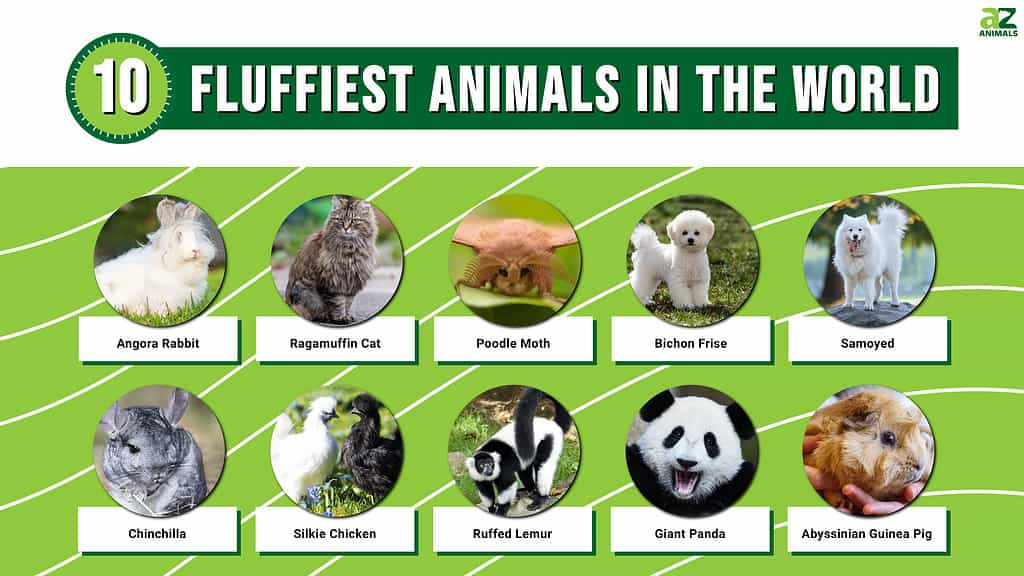
#10 Abyssinian Guinea Pig

Guinea pigs’ fur grows over their body in interesting whorls that are called rosettes.
©Tettania/Shutterstock.com
The Abyssinian guinea pig is bred for its fluffy fur, which grows over the body in interesting whorls that are called rosettes. Indeed, if the guinea pig is shown, it must have an even number of these rosettes, preferably eight or 10 on specific areas of the body. Because it is tough to find a guinea pig with these criteria, most Abyssinian guinea pigs are just kept as delightful pets.
Like other fluffy pets, it needs frequent grooming to keep its fur from matting and tangling. Despite their name, guinea pigs are neither pigs or from Guinea. They are rodents from South America, originating from Peru. They were introduced throughout Europe as early as the 16th century by Spanish conquistadors and were prized as exotic pets. Even Queen Elizabeth I was a fan of these noisy little creatures.
Go here for more info on guinea pigs.
#9 Giant Panda
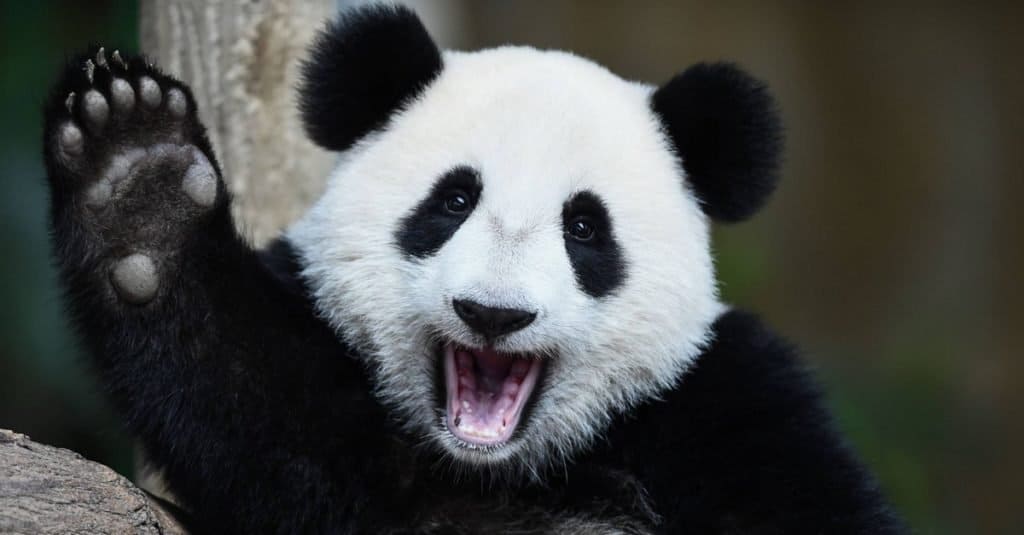
The panda is another avatar of fluffy cuteness.
©V-yan/Shutterstock.com
Another avatar of fluffy cuteness, even though an adult giant panda can weigh up to 280 pounds and stand over 6 feet tall, is this beloved bear of the Chinese bamboo forest that is instantly recognizable. The panda’s fur is mostly white, though it has those black pom-pom-like ears atop its round head, small eyes surrounded by black eye patches, a black nose, a black shoulder saddle, and black arms and legs. It famously eats almost nothing but bamboo in the wild, even though it has a carnivore’s digestive system and is classed as a carnivore. This solitary bear eats at dusk and dawn then sleeps the rest of the day in a bamboo thicket. The good news about the giant panda is that its conservation status has improved from endangered to vulnerable.
Go here for more info on the giant panda.
#8 Ruffed Lemur

The lemur’s ruff runs, like a full chin curtain beard, from the ears to under the chin and around the neck.
©J.NATAYO/Shutterstock.com
Like all lemurs, the ruffed lemur is native to Madagascar. It is the largest member of the Lemuridae family, with a body length of 39 to 47 inches and weight from about 7 to 9 pounds. Generally, the tail of the ruffed lemur is longer than its body and can be over 2 feet long. Its thick, fluffy fur is black and white or white and red. The black and white lemur has a black face and can have black on its chest, flanks, feet, tail, and shoulders. It also has a long, doglike muzzle that reveals several teeth and a claw for grooming its thick fur on its foot. The ruff runs, like a full chin curtain beard, from the ears to under the chin and around the neck. Because much of its habitat has been destroyed, the ruffed lemur is critically endangered.
Go here for more info on lemurs.
#7 Silkie Chicken
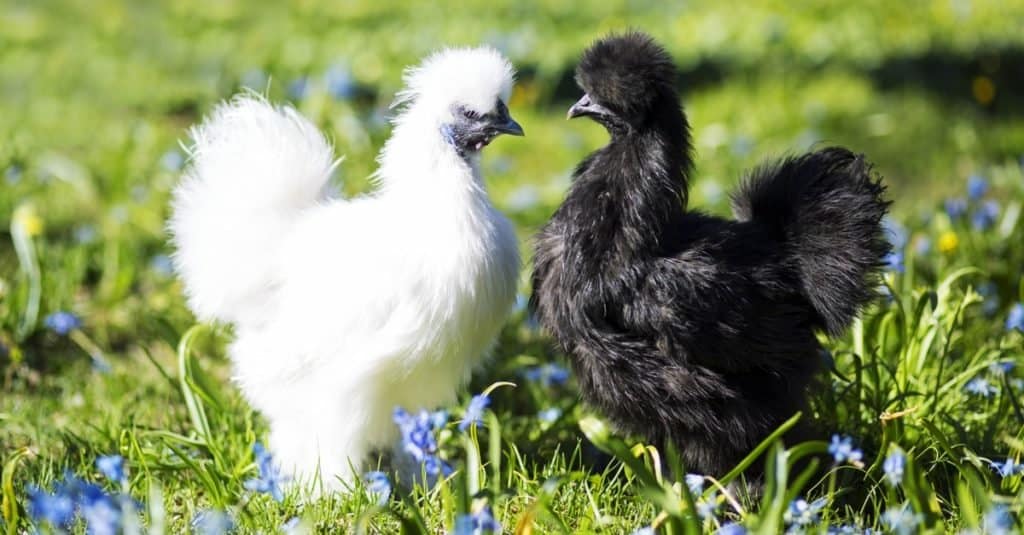
Silkie chickens’ feathers come in several colors, including white, blue, black, gray, and partridge.
©Einar Muoni/Shutterstock.com
This bird, also called the Chinese chicken, has been bred for hundreds of years and is admired for its fluffy, delightfully soft, and silky plumage. It is a small chicken, with the roosters weighing in at about 4 pounds and the hens weighing 3 pounds. There are bantam breeds that are even smaller than this.
Silkie chickens can be bearded or non-bearded. A beard is made up of feathers just under the beak that covers the chicken’s earlobes. Their feathers come in several colors, including white, blue, black, gray, and partridge. A champion silkie needs to have a tiny comb shaped like a walnut, blue earlobes, and dark wattles. Each foot needs to have five toes, and beneath all those fluffy feathers the skin must be black. Despite its exotic looks, the silkie is calm and broody and is often used to incubate eggs from other birds.
Go here for more info on chickens.
#6 Chinchilla
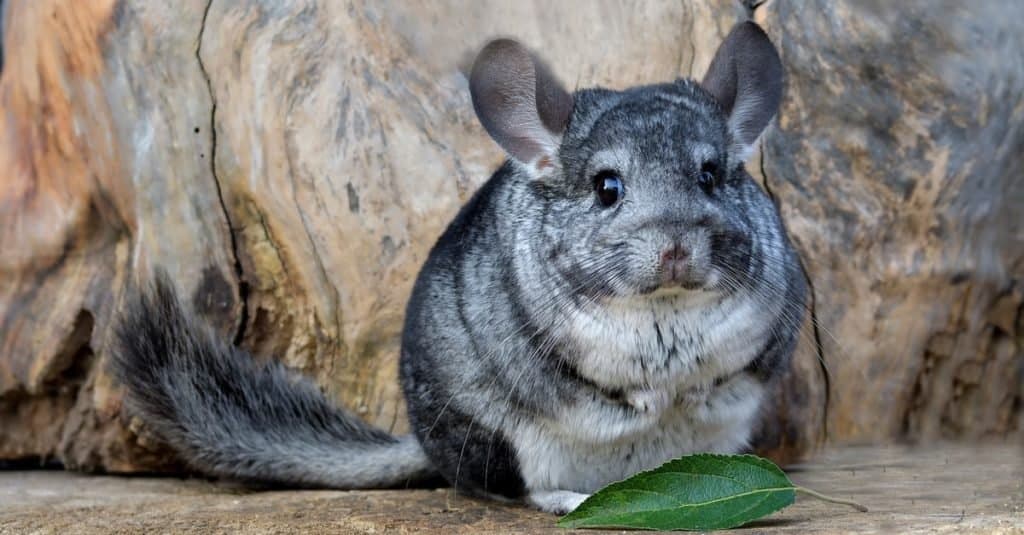
A chinchilla’s fur is considered the softest in the world: 30 times softer than human hair!
©ATTILA Barsan/Shutterstock.com
This medium-sized rodent also evolved its fluffy fur to live in a harsh climate, this time the cold heights of the Andean mountains of western Chile. It has been hunted and farmed for its lush, silvery gray fur for years. Indeed, it has the thickest fur of any terrestrial animal. Because that fur is sought after, both species of chinchilla are considered endangered, and the short-tailed chinchilla is nearly extinct in the wild.
Chinchilla lanigera is about 9 to 15 inches long with a 3 to 5.5-inch long tail and weighs between 1.10 and 1.76 pounds. Chinchilla chinchilla is 12 to 13 inches long, and its tail is 5 to 6 inches long The females are larger than the males. C. chinchilla has more vertebrae in its tail than C. lanigera.
The sweet nature and fluffy cuteness of chinchillas makes them sought after as pets, but they need a great deal of care. The temperature of their enclosure needs to be regulated, their teeth have to be taken care of, and every now and then they need to have a dust bath in fine pumice. They’re easily stressed and also subject to depression.
Go here for more info on chinchillas.
#5. Samoyed
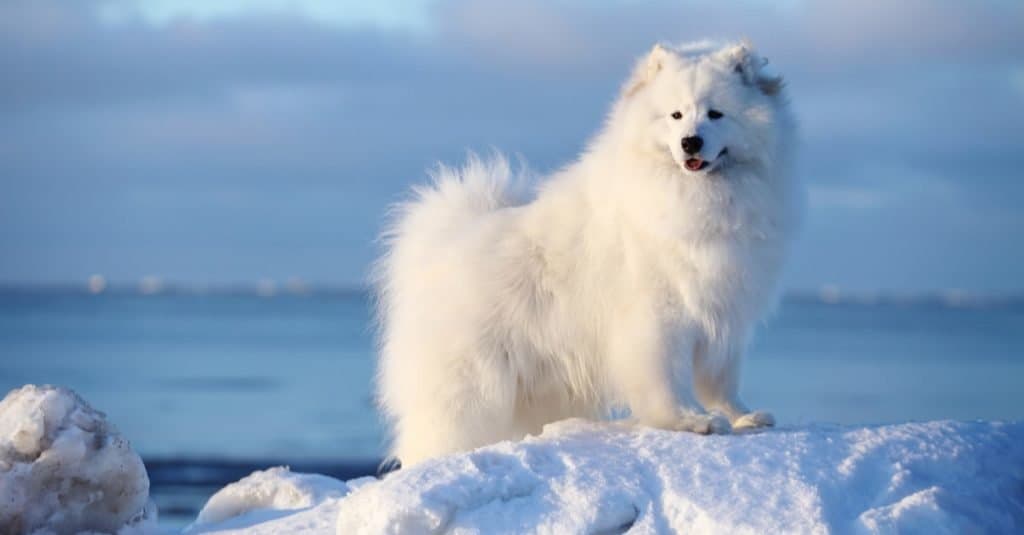
The thick, long fur of the Samoyed was actually once used to make cloths.
©Ilya Barmin/Shutterstock.com
This working dog’s fluffy white coat kept it warm as it herded reindeer in Siberia. It’s a spitz-like dog whose long tail, as fluffy as its body, is carried curled over its back and to one side. The rest of the dog is broad and muscular, and the face has a somewhat foxy look with large, dark brown eyes and thick, small, erect ears. Its legs are powerful, its chest is broad, and it even has fur cushioning its feet. Built for harsh weather, this dog was used by Captain Robert Scott and Roald Amundsen as they explored the South Pole. The Samoyed stands about 18 to 22 inches high at the shoulder and weighs between 50 and 65 pounds.
A 33,000 year old fossil was found that tied the Samoyed breed to the ancient wolf. The Samoyede tribe, native to Siberia, first used these dogs for hunting before discovering their talent as reindeer herders. The thick, long fur of the Samoyed was actually used to make cloths, and the dogs slept with the children of the tribe at night to provide warmth.
Go here for more info on the Samoyed.
#4. Bichon Frise

The Bichon Frise’s fur is soft, silken, and grows in soft curls all over the body.
©Ieva Tvaronavicute/Shutterstock.com
This pert little dog has a double coat, which gives it the appearance of an animated collection of cotton balls. Its fur is soft, silken, and grows in soft curls all over the body. Bred to be the companion or royalty in 15th century Spain, this portable pooch is only about a foot long from head to its curly tail and weighs about 12 pounds, the same as the Giant Angora rabbit.
Go here for more info on the Bichon Frise.
#3. Poodle Moth

The poodle moth is fluffy, with black eyes and feathered antennae.
©Sanit Fuangnakhon/Shutterstock.com
Also called the puppy moth, the poodle moth looks so much like a cross between a little puppy and a moth that people at first doubted it was real. It does indeed seem to be real, and some biologists believe it belongs in the Bombycidae family of moths. These are the silkworm moths, and the adults are also typically white, fluffy with huge black eyes and feathered antennae.
Domesticated for centuries for the silk that forms their cocoons, silkworm moths no longer fly well. Their bodies are bulky, especially the bodies of the females, and their wings are not strong enough to keep them airborne for a long period of time. As for the poodle moth, though it looks weird in closeup, it is only about an inch long and seems to be endemic to Venezuela.
Go here for more info on moths.
#2. Ragamuffin Cat
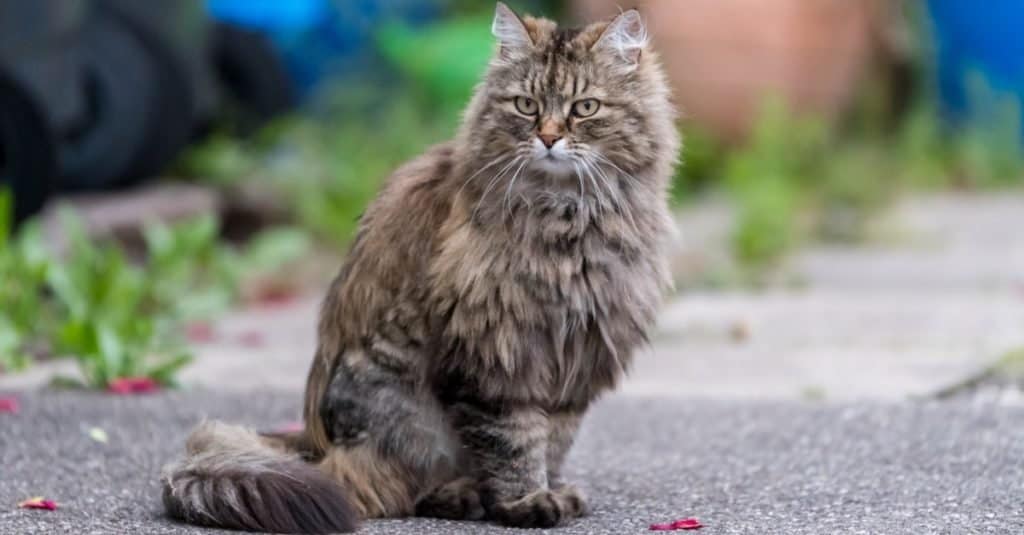
Ragamuffin kittens are actually born white and develop a color pattern as they mature.
©Benjamin B/Shutterstock.com
The fur of this cat is quite similar to that of the Angora rabbit in its fluffiness. It is a big and robust cat with a sweet personality. Females can weigh as much as 15 pounds while males can weigh over 20, and they have the tendency, like their ragdoll cat forbears, of going limp when picked up.
Another good thing about his fluffy cat is that its fur doesn’t need quite as much attention as that of the Angora rabbit’s, for it doesn’t readily tangle. It just needs a once-a-week brushing. Though the ragamuffin cat can have a variety of coat colors, the kittens are born white and acquire their colors as they grow up, which can take as long as four years. Another good thing is that a well-cared-for ragamuffin can live to be 18.
Go here for more info on pet cats.
#1. Angora Rabbit
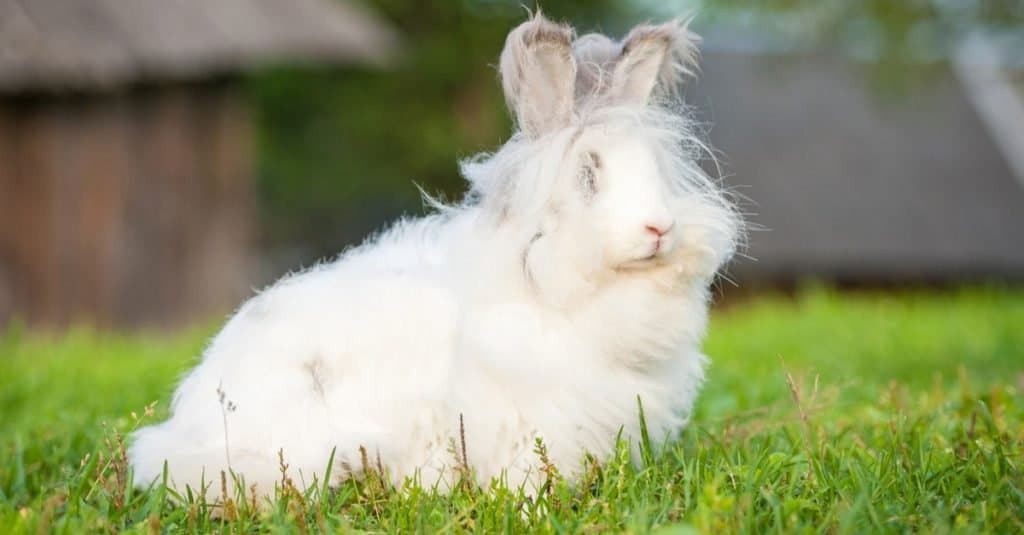
Angora rabbits’ soft, fine, long fur is used to make Angora wool.
©Rita_Kochmarjova/Shutterstock.com
Rabbits, even wild ones, are avatars of fluffy cuddliness, but some rabbits are fluffier than others. One of the fluffier rabbits is the Angora, bred specifically for its coat, whose soft, fine, long fur is used to make Angora wool.
The Angora originated in Turkey and was brought to Europe in the early decades of the 18th century. There are about 11 breeds of Angora rabbit, and they range from the petite 4 pound English Angora to the fittingly named Giant Angora, which weighs at least 12 pounds and can produce over a pound of wool at a single shearing.
Because of the abundance of their fluff, Angora rabbits must be groomed daily. If the coat is neglected, the fur can mat. This can not only cause the animal discomfort but can actually make them sick. They are especially susceptible to a disorder called wool block. As rabbits groom themselves, they eventually ingest a bit of their fur. If it builds up in the digestive system, the rabbit won’t be able to pass it, which can lead to a fatal blockage. So, shearing and plucking the rabbit’s fur regularly is good for both the rabbit and the Angora wool trade.
Go here for more info on rabbits.
Summary of the Top 10 Fluffiest Animals in the World
Here’s a look back at those fluffy cutie-pies that made our top 10 list:
| Rank | Animal |
|---|---|
| 1 | Angora Rabbit |
| 2 | Ragamuffin Cat |
| 3 | Poodle Moth |
| 4 | Bichon Frise |
| 5 | Samoyed |
| 6 | Chinchilla |
| 7 | Silkie Chicken |
| 8 | Ruffed Lemur |
| 9 | Giant Panda |
| 10 | Abyssinian Guinea Pig |
Up Next…
- Top 10 Wild Dog Breeds in the World — Wolves, foxes, coyotes, jackals…these are just some of the wild dog breeds that roam our planet. Find out the top 10 in this fascinating read.
- The 15 Laziest Animals in The World — Some animals are just so lazy, it’s a wonder they have survived in the wild. Here’s a look at the 15 laziest animals, and some may surprise you!
- The 10 Most Amazing Mountain Animals — Check out these awesome mountain dwellers who beat the odds in the highest of Earth’s elevations.
The photo featured at the top of this post is © Rita_Kochmarjova/Shutterstock.com
Thank you for reading! Have some feedback for us? Contact the AZ Animals editorial team.






